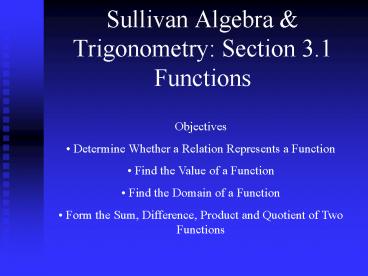Sullivan Algebra - PowerPoint PPT Presentation
1 / 15
Title:
Sullivan Algebra
Description:
Sullivan Algebra & Trigonometry: Section 3.1 Functions Objectives Determine Whether a Relation Represents a Function Find the Value of a Function Find the Domain of a ... – PowerPoint PPT presentation
Number of Views:127
Avg rating:3.0/5.0
Title: Sullivan Algebra
1
Sullivan Algebra Trigonometry Section
3.1Functions
- Objectives
- Determine Whether a Relation Represents a
Function - Find the Value of a Function
- Find the Domain of a Function
- Form the Sum, Difference, Product and Quotient
of Two Functions
2
Let X and Y be two nonempty sets of real numbers.
A function from X into Y is a relation that
associates with each element of X a unique
element of Y.
The set X is called the domain of the function.
For each element x in X, the corresponding
element y in Y is called the image of x. The set
of all images of the elements of the domain is
called the range of the function.
3
f
x
y
x
y
x
X
Y
RANGE
DOMAIN
4
Example Which of the following relations are
function?
(1, 1), (2, 4), (3, 9), (-3, 9)
A Function
(1, 1), (1, -1), (2, 4), (4, 9)
Not A Function
5
Functions are often denoted by letters such as f,
F, g, G, and others. The symbol f(x), read f of
x or f at x, is the number that results when x
is given and the function f is applied.
Elements of the domain, x, can be though of as
input and the result obtained when the function
is applied can be though of as output.
Restrictions on this input/output machine 1.
It only accepts numbers from the domain of the
function. 2. For each input, there is exactly
one output (which may be repeated for
different inputs).
6
For a function y f(x), the variable x is called
the independent variable, because it can be
assigned any of the permissible numbers from the
domain.
The variable y is called the dependent variable,
because its value depends on x.
The independent variable is also called the
argument of the function.
7
Example Given the function
Find
f (x) is the number that results when the number
x is applied to the rule for f.
Find
8
The domain of a function f is the set of real
numbers such that the rule of the function makes
sense.
Domain can also be thought of as the set of all
possible input for the function machine.
Example Find the domain of the following
function
Domain All real numbers
9
Example Find the domain of the following
function
Example Find the domain of the following
function
10
Example Express the area of a circle as a
function of its radius.
The dependent variable is A and the independent
variable is r.
11
If f and g are functions, their sum f g is the
function given by
(f g)(x) f(x) g(x).
The domain of f g consists of the numbers x
that are in the domain of f and in the domain of
g.
If f and g are functions, their difference f - g
is the function given by
(f - g)(x) f(x) - g(x).
The domain of f - g consists of the numbers x
that are in the domain of f and in the domain of
g.
12
(No Transcript)
13
Example Define the functions f and g as follows
Find each of the following and determine the
domain of the resulting function.
a.) (f g)(x)
f(x) g(x)
14
b.) (f - g)(x)
f(x) - g(x)
c.) ( )(x)
f(x)g(x)
15
d.)
We must exclude x - 4 and x 4 from the domain
since g(x) 0 when x 4 or - 4.































